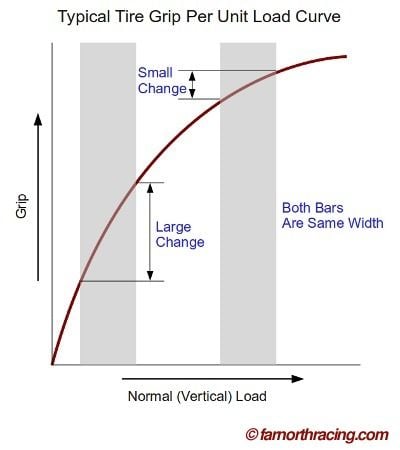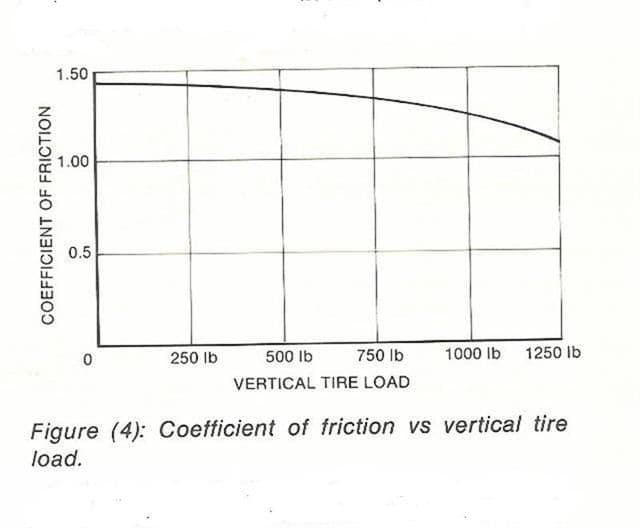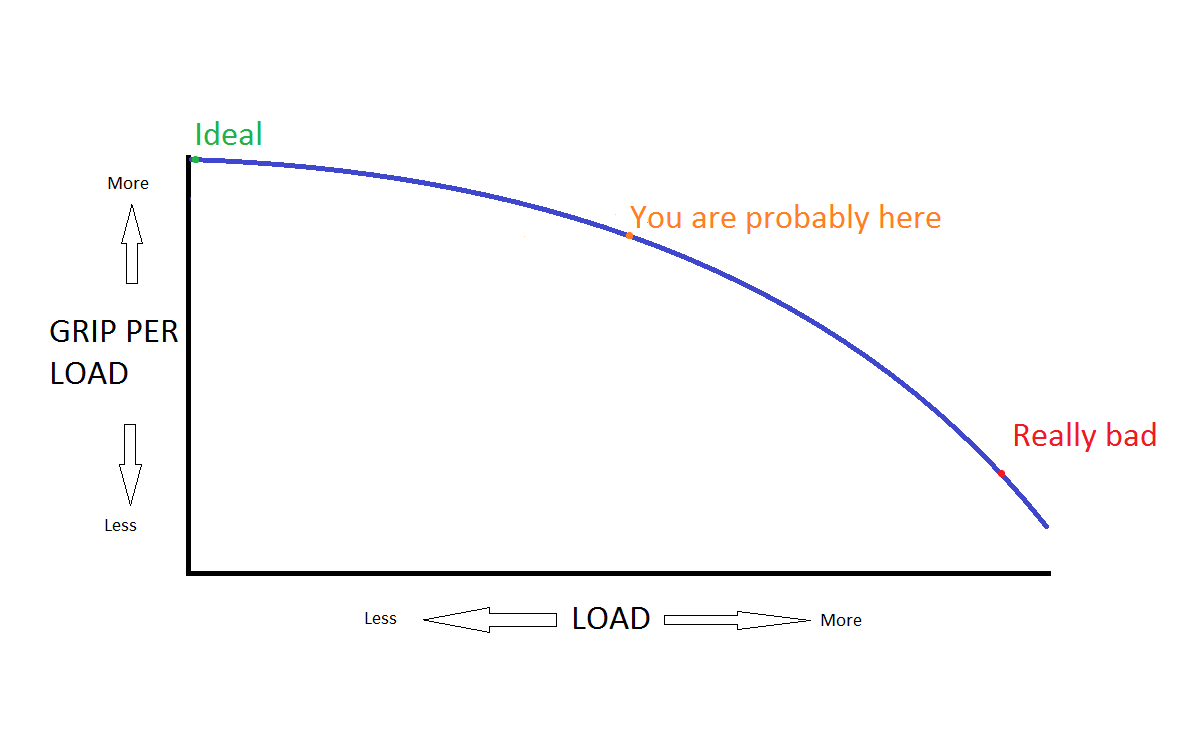Lexus is moving away from sedans and toward SUVs
#136
Lexus Fanatic
LOL, no. The issue is one of inertia as Och said. It takes a much larger force to halt the inertia of a heavier object, and when traction is an issue the simple weight of the vehicle on the ground is not enough to stop that inertia.
#138
Lexus Fanatic
Also, where the weight is centered (and weight-transfer) makes as much, if not more difference, than the total weight itself. That's why (as I explained above) rear-engine cars, particularly Porsches, have such short braking distances.
Last edited by mmarshall; 02-22-17 at 08:05 PM.
#139
Physics itself also says that, on a slippery surface, more weight on a tire, all else equal, means more traction.
Weight-transfer under heavy braking loads also comes into play. That is one reason why rear-engined Porsches have such short stopping distances. The forward weight-transfer under braking places the maximum weight near the center of the car, making all four tires do roughly an equal share of the braking load. In a FWD car, the rear wheels do very little of the braking.....and can fishtail easily on a slick surface if the brake-proportioning valve is not set up correctly.
Weight-transfer under heavy braking loads also comes into play. That is one reason why rear-engined Porsches have such short stopping distances. The forward weight-transfer under braking places the maximum weight near the center of the car, making all four tires do roughly an equal share of the braking load. In a FWD car, the rear wheels do very little of the braking.....and can fishtail easily on a slick surface if the brake-proportioning valve is not set up correctly.
This notion that increase in weight increases the tire grip is very commonly applied to the very heavy Tesla Model S to justify the weight of its battery pack.
Unfortunately, while weight is inversely proportional to braking force and deceleration, the increase in weight is not exactly proportional to increase in coefficient of friction, nor exactly proportional to braking grip.
As the weight increases, the coefficient of friction and the braking force will increase to a certain extent, and beyond a certain limit [threshold], increases in weight will actually decrease the coefficient of friction, thereby decreasing the braking grip.
If you ask me why, the answer has to do with something about excess weight causing the tires to behave in a "liquid-like" fashion, acting like a lubricant, to actually decrease the grip of the tires.
That's why all the excess weight of the Tesla Model S doesn't really work, otherwise Elon Musk would build the Model S out of conventional steel, to increase the weight of his Model S, to achieve even more grip, yet save so much more production costs compared to his aluminium spaceframe.

Notice how the co-efficient of friction decreases with the increase in load below?
Has something to do with the surface "liquefying" to decrease the friction.
Thus AWD not only helps acceleration, it also helps deceleration with engine braking.
AWD also helps with more rear weight distribution to help counter nose dive, and front weight transfer.


Last edited by peteharvey; 02-22-17 at 09:24 PM.
#140
Lexus Fanatic
I'm sorry Mike, but you don't know what you're talking about here...
#141
Lexus Fanatic
Here's a good article on the subject. It clearly explains what I was saying about the more of the vehicle's weight (within limits) in the rear, the better-balanced and more even the braking will be. That's why the Porsche 911 excels in short braking distances.....despite its weight.
http://automotivethinker.com/chassis...s-not-optimal/
http://automotivethinker.com/chassis...s-not-optimal/
#142
Lexus Fanatic
Back on the thread topic (Lexus moving towards SUVs), there's currently a good offer on the NX200t....a 3-year, $329 per month lease with $3399 down. That price is good on both FWD and AWD versions......which, IMO, makes the AWD version a better bargain. I'm generally not a fan of the NX (on a review, I found the NX's road manners and refinement notably lacking in relation to the larger RX, even considering the difference in price). But the NX, of course, is a way to get one's foot in the door as a Lexus owner, with Lexus reliability and that noted customer service, and its AWD will come in handy on slippery roads.
http://www.lexus.com/models/NX/offers
http://www.lexus.com/models/NX/offers
#143
Super Moderator

Here's a good article on the subject. It clearly explains what I was saying about the more of the vehicle's weight (within limits) in the rear, the better-balanced and more even the braking will be. That's why the Porsche 911 excels in short braking distances.....despite its weight.
http://automotivethinker.com/chassis...s-not-optimal/
http://automotivethinker.com/chassis...s-not-optimal/
Physics itself also says that, on a slippery surface, more weight on a tire, all else equal, means more traction.
#144
Originally Posted by Och
There isn't much difference between modern RWD vs FWD in snow provided they both equipped with similar set of tires. Of course with similar tires AWD will fare even better, except when it comes to braking - the added weight of AWD can actually make things worse.
That being said, I've never had a problem here in NE with RWD + snow tires, and what can possibly be more fun than doing some donuts in snow with RWD car?
That being said, I've never had a problem here in NE with RWD + snow tires, and what can possibly be more fun than doing some donuts in snow with RWD car?

 +1 for snow tire and rear or all wheel drive. Unstoppable in the snow (except when braking) and extends the life of your 2/3 season performance tires.
+1 for snow tire and rear or all wheel drive. Unstoppable in the snow (except when braking) and extends the life of your 2/3 season performance tires.
#145
Originally Posted by SW15LS
FWD vehicles are easier to get going from a stop in the snow, but actually can be far more dangerous to steer because your directional wheels and power wheels are the same. When you have a loss of steering traction, you have a loss of throttle traction and vice versa.
RWD with snow tires is actually much safer to drive in the snow.
Amd weight is is always the enemy of braking. Physics is physics.
RWD with snow tires is actually much safer to drive in the snow.
Amd weight is is always the enemy of braking. Physics is physics.
#146
Lexus Fanatic
What kind of condition were the front tires in? In general, the balder they are, the more likely they are to lose traction, although that is more the case in water than in snow or ice.
#147
Lexus Fanatic
[QUOTE=geko29;9782836]That's talking about weight DISTRIBUTION. You were talking about weight, full stop. The 911 has great breaking in part because of where it puts the weight it does have (ie, doesn't overweight the front end). But adding an extra 1000 lbs to the car won't make it stop better. And that's what you were saying before.[quote]
I was talking about both, to some extent. And, BTW, since you bring up the subject of adding weight in the trunk, pickup drivers routinely do that in the snow on RWD models for better traction. If noting else, sometimes they will just take a snow shovel and load the bed up with snow. That's an old trick that dates back many years...and it works.
I was talking about both, to some extent. And, BTW, since you bring up the subject of adding weight in the trunk, pickup drivers routinely do that in the snow on RWD models for better traction. If noting else, sometimes they will just take a snow shovel and load the bed up with snow. That's an old trick that dates back many years...and it works.
#148
Lexus Champion
iTrader: (3)
I was talking about both, to some extent. And, BTW, since you bring up the subject of adding weight in the trunk, pickup drivers routinely do that in the snow on RWD models for better traction. If noting else, sometimes they will just take a snow shovel and load the bed up with snow. That's an old trick that dates back many years...and it works.
#149
Lexus Fanatic
No sense arguing on and on about weight. We've all had our say. I'm done on that subject. We've gotten off topic....Lexus sedans vs. SUVs.
Anyhow, I posted what I did about the NX lease-offers because they looked pretty attractive to those who might be interested in one. Not my cup of tea (the NX is not refined enough for my tastes).....but it's a good way for an aspiring Lexus owner to get his or her foot through the door.
Anyhow, I posted what I did about the NX lease-offers because they looked pretty attractive to those who might be interested in one. Not my cup of tea (the NX is not refined enough for my tastes).....but it's a good way for an aspiring Lexus owner to get his or her foot through the door.
Last edited by mmarshall; 02-25-17 at 07:37 AM.
#150
Lexus Fanatic
If you take some advanced driving training courses they teach this, in the hands of somebody with an even rudimentary understanding of how to control a vehicle in a skid, a RWD car is clearly safer to control.
Big issue with RWD in the snow is getting moving, but modern traction aids help a lot with that, and winter tires help a ton. So given the choice, I would take a RWD car with winter tires over a FWD car with or without winter tires in the snow any day of the week. I might even take a RWD car with all seasons and good traction control.
What it comes down to, is that FWD is just not a superior drivetrain setup in any situation other than 1. Being less expensive to design and produce, 2. Saving space in the cabin of the vehicle. I'll tolerate it in my van because I do benefit from the interior space packaging, but having the experience I have and the premium cars I've had, I just don't want anything to do with it in most vehicles I would purchase.
I've used the analogy before...its like a Quartz vs Automatic movement in a watch. The Quartz is fine, but any truly premium or luxury watch will be Automatic movement, and anybody who knows and understands watches is going to look down on a Quartz movement. My watch is a quartz movement...but I'm not a watch enthusiast. I AM a car enthusiast, and I understand the benefits of a proper longitudinal RWD setup, and thats what I want.
That's talking about weight DISTRIBUTION. You were talking about weight, full stop. The 911 has great breaking in part because of where it puts the weight it does have (ie, doesn't overweight the front end). But adding an extra 1000 lbs to the car won't make it stop better. And that's what you were saying before.
Last edited by SW17LS; 02-25-17 at 08:28 AM.


